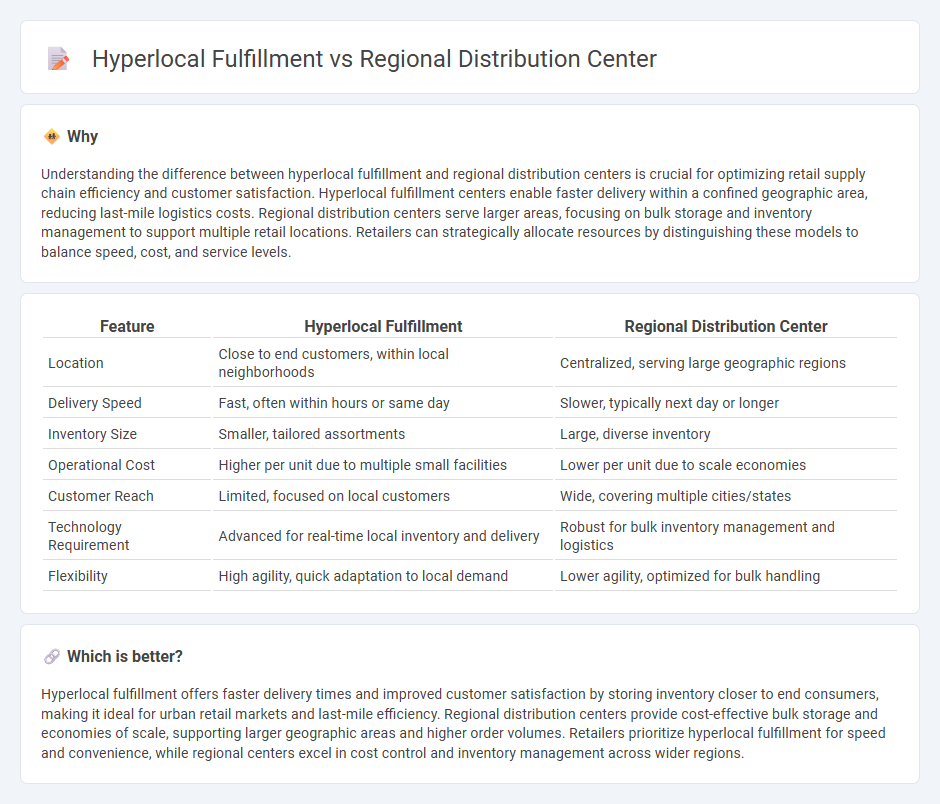
Hyperlocal fulfillment centers serve customers within a few miles by storing inventory closer to demand, enabling faster delivery and increased convenience for urban shoppers. Regional distribution centers cover broader areas by consolidating and dispatching large volumes of products to multiple retail locations, optimizing supply chain efficiency and reducing transportation costs. Discover the key differences and strategic benefits of hyperlocal fulfillment versus regional distribution centers to enhance retail operations.
Why it is important
Understanding the difference between hyperlocal fulfillment and regional distribution centers is crucial for optimizing retail supply chain efficiency and customer satisfaction. Hyperlocal fulfillment centers enable faster delivery within a confined geographic area, reducing last-mile logistics costs. Regional distribution centers serve larger areas, focusing on bulk storage and inventory management to support multiple retail locations. Retailers can strategically allocate resources by distinguishing these models to balance speed, cost, and service levels.
Comparison Table
| Feature | Hyperlocal Fulfillment | Regional Distribution Center |
|---|---|---|
| Location | Close to end customers, within local neighborhoods | Centralized, serving large geographic regions |
| Delivery Speed | Fast, often within hours or same day | Slower, typically next day or longer |
| Inventory Size | Smaller, tailored assortments | Large, diverse inventory |
| Operational Cost | Higher per unit due to multiple small facilities | Lower per unit due to scale economies |
| Customer Reach | Limited, focused on local customers | Wide, covering multiple cities/states |
| Technology Requirement | Advanced for real-time local inventory and delivery | Robust for bulk inventory management and logistics |
| Flexibility | High agility, quick adaptation to local demand | Lower agility, optimized for bulk handling |
Which is better?
Hyperlocal fulfillment offers faster delivery times and improved customer satisfaction by storing inventory closer to end consumers, making it ideal for urban retail markets and last-mile efficiency. Regional distribution centers provide cost-effective bulk storage and economies of scale, supporting larger geographic areas and higher order volumes. Retailers prioritize hyperlocal fulfillment for speed and convenience, while regional centers excel in cost control and inventory management across wider regions.
Connection
Hyperlocal fulfillment relies on regional distribution centers (RDCs) to efficiently supply goods closer to end consumers, reducing delivery times and transportation costs. RDCs act as strategic hubs that store inventory near high-demand areas, enabling retailers to fulfill orders rapidly through local delivery partners and stores. This integration enhances customer satisfaction by ensuring faster availability of products and streamlining last-mile logistics.
Key Terms
Inventory Centralization vs. Decentralization
Regional distribution centers centralize inventory to streamline bulk storage and reduce transportation costs across wider geographic zones, enhancing supply chain efficiency by consolidating stock in fewer locations. In contrast, hyperlocal fulfillment decentralizes inventory to multiple small-scale warehouses near end customers, enabling faster delivery times and improved responsiveness to local demand fluctuations. Explore how strategic inventory centralization and decentralization impact your logistics performance and customer satisfaction.
Delivery Speed
Regional distribution centers optimize delivery speed by centralizing inventory in strategically located warehouses, enabling faster dispatch to broad geographic areas. Hyperlocal fulfillment enhances delivery speed through proximity, utilizing smaller hubs or local stores to offer same-day or even instant delivery within a limited radius. Explore the advantages and applications of both models to identify the best fit for your delivery strategy.
Service Area Coverage
Regional distribution centers (RDCs) serve broad geographic areas, enabling centralized inventory management and bulk order processing to optimize logistics for large-scale operations. Hyperlocal fulfillment centers concentrate on immediate neighborhoods or small urban zones, accelerating delivery times and offering personalized service with lower transportation costs. Explore the strategic advantages of each approach to determine the best fit for your service area coverage needs.
Source and External Links
Regional vs. Centralized Distribution: Evaluating Approaches for ... - A regional distribution center (RDC) is strategically located in different geographic regions to enable faster deliveries and better meet customer expectations by reducing transit times compared to centralized distribution models, though it can introduce challenges in inventory management across multiple centers.
What is RDC Delivery? Regional Distribution Centres - Geo2 - RDCs are large warehouses that improve supply chain efficiency by storing goods before local distribution, enabling faster delivery to end customers, reducing transportation costs, and enhancing risk management by spreading operations across multiple regional hubs.
What is Regional Distribution Center (RDC)? - Al Sharqi - An RDC is a warehouse strategically positioned within a region to store and distribute products to retail stores or customers, receiving goods from suppliers and redistributing them within a specific geographic area.
 dowidth.com
dowidth.com